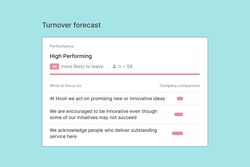
Understanding and calculating the cost of employee turnover

Written by

Senior Content Marketing Manager, Culture Amp
Nobody enjoys turnover – not HR, not leadership, not managers, and not the colleagues who have worked alongside the person exiting the company.
Even if you can look on the bright side of an employee exit, there are real emotional and operational costs that come with churn. The competition to attract the best people has always been fierce, but hiring them is only half the battle – especially during The Great Resignation. With turnover at an all-time high, replacing an employee can take more time and be even more costly than before.
In this blog, we’ll explore the factors that drive turnover and explain why employee engagement is key to driving retention. Then, we’ll look at how the Culture Amp platform can help you calculate the cost of employee turnover and take action to retain your employees.
Understanding the factors that affect employee turnover
Why do people choose to leave? A straightforward explanation is compensation – though we at Culture Amp don’t believe that salary is a particularly effective lever for meaningfully increasing retention, assuming that your compensation practices are fair.
Didier Elzinga, CEO of Culture Amp, explains, “It’s never useful to try and engage a person to stay if all they ask for is more money. If this is the case, you’ve already lost the battle because they’ve reduced their decision to a purely monetary transaction. If you do match their salary, they’ll be gone within six months when someone else increases that number.”
So what are some factors that will tip the scales on an employee’s decision to stay or leave?
According to a recent Gallup study, The Great Resignation is primarily fueled by workplace issues rather than industry, role, or pay issues, as many expected. According to their data, the highest quit rate is among “not engaged” and “actively disengaged” workers. In other words, retention and engagement are deeply intertwined.
This finding isn’t anything new – as early as 2004, quantitative analysis by Corporate Leadership Council found that engaged employees are "87 percent less likely to leave the organization." An internal study by financial services giant Standard Chartered found similar results. Among their branches, those with high employee engagement had 46% less voluntary turnover.
Fortunately, science-backed engagement surveys make it simple and intuitive to pinpoint and take action on the high-impact areas driving employee discontent and disengagement. Once you’ve collected the data, you can use feedback from this survey to understand what specific factors might lead people at your company to leave in the future.
In our years working with over 4,000 companies, we’ve found that a focus on the following can improve engagement, increase retention, and reduce the cost and impact of turnover:
Company leadership
Let’s get one popular myth out: "People quit bosses, not companies.” Our People Scientists dug into the data and discovered that managers certainly matter, but not nearly as much as overall leadership. We found that the percentage of people whose decision to leave an organization was driven by a manager or pay was roughly even at 12% and 11%, respectively. Leadership was more than double that at 28%.
Looking into our 2021 engagement survey benchmark, we found that leadership was the highest driver of engagement globally, with 78% of engaged employees agreeing or strongly agreeing with the statement: “I have confidence in the leaders at [Company].” In other words, strong leadership is essential for engaging and retaining your employees.
Learning and development
We also discovered that learning and development are key factors that employees weigh when deciding whether or not to leave. In the same “People quit managers, not companies” study, our People Scientists found that the percentage of people whose decision to leave was driven by development was 52% – dwarfing the manager, pay, and leadership factor.
These numbers hold up when looking at our 2021 benchmarks – the second-highest driver globally was related to progress and growth, as assessed with the statement, “At [Company], I am making good progress in my career and development goals.”
Fresia Jackson, Lead Research People Scientist at Culture Amp, found similar results in a separate study examining why high-performing employees leave. She reports, “Employees who left were less favorable on the question ‘I believe there are good career opportunities for me at [Company].’ Additionally, a lack of Growth (in their career or development opportunities) was selected by 1 in 3 employees as a top reason for leaving at the time of exit.”
All this makes sense. Why would your employees choose to stay in the long run without clear pathways and opportunities for growth and development? A genuine commitment to learning and development can show employees that their company is ready and willing to invest in their success - not just now but in the long run.
Belonging
In the same study above, Fresia reported that a sense of belonging is crucial for people joining a company. People who felt early on that they didn’t belong were three times more likely to leave within the first six months. Why is this the case? We’ve found that even when accounting for differences across demographics, employees are more likely to be engaged if they feel like they belong. So if your goal is to reduce turnover, you can’t go wrong with fostering a culture of belonging in your workplace.
Calculating the cost of employee turnover
Understanding the cost of employee turnover is important for both the business and the wellbeing of your employees. But without hard numbers, it’s challenging to get executive buy-in for the employee engagement initiatives necessary to improve retention and transform the employee experience.
Unfortunately, it’s not easy to nail down the cost of employee turnover because of the numerous variables that must be factored into the calculations. For example, your Sales and Legal teams might have the following average salaries and turnover rates:
Sales: 90K average and 20% turnover
Legal: 200K avg and 4% turnover
In this case, you need to decide between discussing the two departments separately or fusing them into an overall company average salary and turnover rate. The first option is more precise but is more time and labor-consuming. The second is easier to understand but may feel disconnected when looking at fringe departments.
Moreover, estimates of the cost of turnover vary considerably. Our research has found that they range from 30% to 200% of a person’s salary. This variance presents another challenge for companies trying to calculate the cost of turnover and is rooted in the range of costs associated with:
- Advertising on job boards
- Recruitment and agency fees
- Candidate testing
- Impact on the engagement of other employees
- Effect on other employees’ intention to leave
- Lost productivity
- Impact on your organization’s ability to reach current goals and resource future goals
- Increase in the potential for errors
- Interviews
- New equipment
In particular, turnover costs can vary significantly based on the type of employee leaving. For example, the exit of a tenured executive is almost certainly more costly than an individual contributor who’s been with the company for less than a year. That’s why figuring out why your employees leave is essential for retaining your top talent and reducing the cost of turnover.
Culture Amp makes it easier to understand your turnover costs by using predictive analytics to develop a turnover forecast for your company. By leveraging data from your forecast, your industry’s average salary, and the average cost of turnover, the platform can give you a personalized turnover cost estimate that can help shape your retention strategy.
Commit to culture, keep your people
If employee engagement isn’t on your C-suite’s radar, it needs to be. Turnover is costly. A culture of engagement doesn’t just attract great people – it helps you keep your best employees with you.

Increase retention by boosting engagement
Forecast employee turnover with Culture Amp’s predictive analytics capabilities

